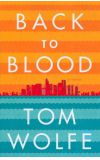
01 Nov 2012 00:56:12
Lurching through Tom Wolfe's 700-page new novel with its cast of porn-addicts, body-builders, art-collectors, suave oligarchs and foxy jebitas, all sizzling together under the Miami sun, I understood Naipaul's qualms. It isn't that Back to Blood is entirely about sex and shopping, or even that it is entirely bad. But between its pandering tackiness, and its polemical grandstanding on behalf of its own supposedly realist aesthetic (it starts out with a newspaper editor on his way to a restaurant called Balzac's, and devotes many pages to ridiculing non-representational art, that dreaded threat to mankind), it leaves you with the feeling that if this is what a novel is, then maybe it really is time to move on.
The aim, squarely Victorian, is to "do" Miami in full cross-section: vertically from city hall to the projects, and horizontally through the principle ethnicities and subcultures – Cubans, Haitians, Anglos, Russian billionaires, Jewish retirees.
There's a political storyline fuelled by the antics of a ripped young rooky cop, Nestor Camacho, who keeps inadvertantly triggering near-riots in various sectors of the population as his well-intentioned acts of derring-do – rescuing a would-be Cuban immigrant from the top of a mast; tackling an enormous African American crack dealer – are subjected to the warping media misrepresentation inevitable in a city where, as Wolfe would have it, "everybody hates everybody". The buttons here – race, immigration, drugs, gangs – are hot, and Wolfe pushes them frantically, but also perfunctorily, building his dramas with so little regard for plausibility it's hard to believe he really cares a damn about the issues themselves (certainly not in the sense that The Wire, for example, cared about Baltimore's). And beyond some touristic local colour ("somehow all the little bakeries and diners in Hialeah used only white bags") there's little indication he cares much about the physical textures of Miami either. At any rate, this aspect of the book falls completely flat.
Then there's a more anthropological storyline, having to do with art, sex and status, and rigged around the question of whether some abstract paintings endowed by a certain Sergei Korolyov to the city's new art museum, and allegedly worth $70m, are in fact fakes. The linchpin in this plot is Camacho's one-time girlfriend Magdalena, all curving lips and breasts and "perfect lissome legs", who dumps him to trade up, first to her celebrity sex-therapist boss Norm Lewis and then to Korolyov himself. Relentlessly mean-spirited as this piece of the plot is (its key image is a photo secretly taken by the manipulative Lewis, showing the herpes-measled genitalia of a rich patient he is currently exploiting for his high-society connections), its themes do at least seem closer to Wolfe's heart, and they produce some correspondingly livelier passages, particularly in the second half of the book.
The first half, however, is uniformly awful. There was a time when Wolfe's sharp eye and acid tongue seemed the perfect instruments for conveying the everlasting face-off between elite and street that generates so much of the theatre of American life. But in Back to Blood those instruments have largely been replaced by a megaphone.
Where he once dissected, he now merely amplifies. Italics, repetition, exclamation marks, screaming caps, have become his stylistic mainstays, supplemented by laboriously spelled-out sound effects and foreign accents. "He could just see the lubricants and spirochetes oozing into the crotches of their short short-shorts! Short short short-shorts! Sex! Sex! Sex! Sex! …" goes a typical passage. Things aren't ugly, they're "uuuuuuug-lyyy". A man can't just laugh, he has to go: "AahhhuhwaaaAHHHHHock hock hock hock" – repeatedly. Then there's the gleefully in-your-face stereotyping: thuggish Russians, indignant Cubans, kvetching Jewish yentas; the flaccid emphasis of "He was a classic Americano … very proper-looking. Over-the-top proper"; the lazy tautology of people seeing even themselves as stereotypes: "He himself realised that Edward T Topping IV was white Anglo-Saxon Protestant to the maximum, to the point of satire". And there's the thought-bubble inner life of the characters (Wolfe has patented a surpassingly annoying typographic device for conveying this – six sets of colons either side of a character's private observation, ie: "::::::This place is a real piece of work!::::::"). No doubt all this is knowingly, deliberately, "mimetically" crass, but so what? That doesn't amount to insight or irony, just crassness squared.

